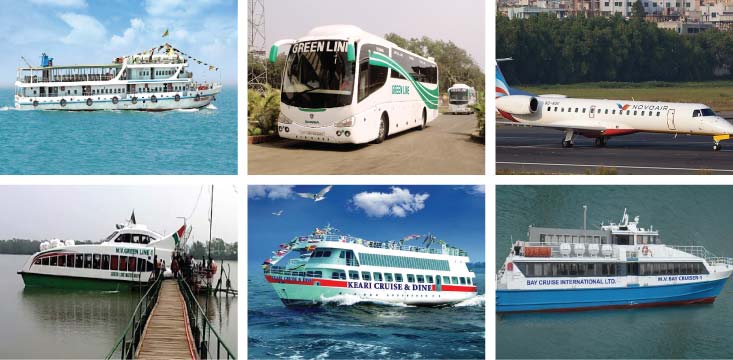+88 01730 450099
[email protected]
Dhaka [ Bengali: ঢাকা ] is the capital and largest city of Bangladesh. Located in an eponymous district and division, it lies along the east bank of the Buriganga River in the heart of the Bengal delta. The city is a microcosm of the entire country, with diverse religious and ethnic communities. Dhaka is the economic, cultural and political center of Bangladesh. Its name was romanized as Dacca until the current spelling was adopted in 1983. It is a major financial center of South Asia. It is one of the world's most populated cities and within OIC countries, with a population of 17 million people in the Greater Dhaka Area. It is also the 4th most densely populated city in the world.
At the height of its medieval glory, Dhaka was regarded as one of the wealthiest and most prosperous cities in the world. It was the Mughal capital of Bengal. The city's name was Jahangir Nagar (City of Jahangir) in the 17th century. It was central to the economy of Mughal Bengal, which generated 50% of Mughal GDP. It was a cosmopolitan commercial center and the hub of the worldwide muslin and silk trade.
The Mughals decorated the city with well-laid out gardens, tombs, mosques, palaces and forts. Dhaka became known as the City of Mosques in Bengal. It was also described as the Venice of the East. The old city was home to various Eurasian merchant groups. The city hosted two important caravansaries of the subcontinent: the Bara Katra and Choto Katra, located on the riverfront of the Buriganga. Modern Dhaka developed from the late 20th century under the administration of East Pakistan. Between 1905 and 1912, it was the capital of British Eastern Bengal and Assam. In 1947, after the region became known as Pakistan, it became the administrative capital of the eastern wing of Pakistan. It was declared as the legislative capital of Pakistan in 1962. In 1971, it became the capital of an independent Bangladesh.
Dhaka is home to most of the local business conglomerate. Many multinational companies also maintain offices in the city. Dhaka Stock Exchange is one of the largest in South Asia in terms of trading volume and market capitalization. The city is home to a number of regional and international training and development organizations, such as permanent secretariat of BIMSTEC. The city has the largest number of cycle rickshaws and is known as the Rickshaw Capital of the World.
Area: 815.85 Sq. kilometers (approx.)
Population: Seven million (approx.)
Climate: Tropical, with heavy rainfall and bright sunshine in the monsoon and warm for the greater part of the year. The winter months, from November to March, are however, most likeable, cool and pleasant.
Temperature: Max. Min.
Summer 36.7°C 21.1°c
Winter 31.7°C 10.5°c
Rainfall: 2540 mm annually.
Humidity: 80 percent (approx.)
Dhaka is located in central Bangladesh at 23°42′N 90°22′E, on the eastern banks of the Buriganga River. The city lies on the lower reaches of the Ganges Delta and covers a total area of 306.38 square kilometers (118.29 sq mi). Tropical vegetation and moist soils characterize the land, which is flat and close to sea level. This leaves Dhaka susceptible to flooding during the monsoon seasons owing to heavy rainfall and cyclones. Dhaka District is bounded by the districts of Gazipur, Tangail, Munshiganj, Rajbari, Narayanganj, Manikganj.
The administrative Dhaka District was first established in 1772. But, the existence of urbanized settlements in the area that is now Dhaka city – dates from the 7th century. The present day Savar was the capital of the Sanbagh Kingdom during seventh and eighth century. The city area of Dhaka was ruled by the Buddhist kingdom of Kamarupa and the Pala Empire before passing to the control of the Hindu Sena dynasty in the 9th century. Many believe that the name of the city was derived after the establishment of the Goddess Dhakeshwari's temple by Ballal Sena in the 12th century. Dhaka and its surrounding area was identified as Bengalla around that period. The town itself consisted of a few market centers like Lakshmi Bazar, Shankhari Bazar, Tanti Bazar, Patuatuli, Kumartuli, Bania Nagar and Goal Nagar. After the Sena dynasty, Dhaka was successively ruled by the Turkish and Afghan governors descending from the Delhi Sultanate before the arrival of the Mughals in 1608.
The development of townships and a significant growth in population came as the city was proclaimed the capital of Bengal under Mughal rule in 1608. During Mughal rule the areas currently under Dhaka district was famous for its textile products – especially the Muslin. Mughal subahdar Islam Khan was the first administrator of the city. Khan named the town "Jahangir Nagar" (City of Jahangir) in honor of the Mughal emperor Jahangir, although this name was dropped soon after Jahangir's death. The main expansion of the city took place under Mughal general Shaista Khan. The city then measured 19 by 13 kilometers (12 by 8 mi), with a population of nearly a million people. The city passed to the control of the British East India Company in 1757 after the Battle of Plassey and eventually to the Crown, British Empire, in 1765 at the Battle of Bexar. The city's population shrank dramatically during this period as the prominence of Kolkata rose, but substantive development and modernization eventually followed. A modern civic water supply system was introduced in 1874 and electricity supply launched in 1878. The Dhaka Cantonment was established near the city, serving as a base for British and Indian soldiers.
